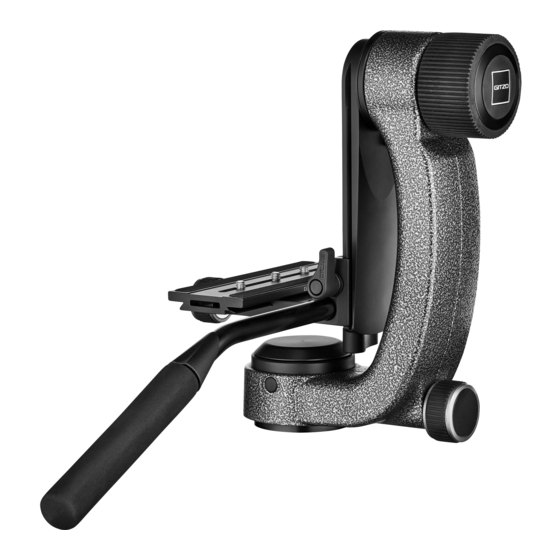
Publicidad
Idiomas disponibles
Idiomas disponibles
Enlaces rápidos
Publicidad

Resumen de contenidos para Gitzo GHFG1
- Página 1 fluid gimbal head...
- Página 3 fluid gimbal head...
- Página 4 Instructions/Istruzioni/Gebrauchsanweisung/Mode d’emploi/Instrucciones 30°...
- Página 5 사용설명서 使用说明/ /使用説明書...
- Página 6 English FIG. 1 – How to mount the lens on the plate FIG. 2 – Find the horizontal balance point - Insert the lens and plate from above. - Holding the lens securely in one hand, unlock the tilt Brake knob “A” with the other hand.
- Página 7 FIG. 4 – Use Tilt Brake knob “A” Pan Brake knob “E” Note with Pan and tilt axis have an appropriate drag level when rotating at low speed during video recording or precise target chase. or if Besides pan axis has a low friction when panning at high speed: your tripod stay in position.
- Página 8 Italiano FIG. 1 - Come montare l'obiettivo sulla piastra FIG. 2 - Trovare il punto di equilibrio orizzontale - Inserire la lente e la piastra dall'alto. - Tenendo la lente saldamente con una mano, sbloccare il freno tilt manopola “A” con l'altra mano. - Posizionare la lente in direzione orizzontale e verificare se rimane orizzontale o se inizia a muoversi.
- Página 9 FIG. 4 - Uso “A”: manopola freno Tilt “E”: manopola freno Pan Nota: I movimenti panoramico e tilt hanno un livello di fluidità tale da consen- tire un’ottimale qualità della ripresa anche con spostamenti ridotti della lente. La testa è dotata di sistema di frizionamento automatico sull’asse panora- mico, che garantisce la stabilità...
- Página 10 Deutsch ABB. 1 – Befestigung des Objektivs an der Platte ABB. 2 – Einstellung des horizontalen Gleichgewichtspunkts - Objektiv und Platte von oben einsetzen. - Objektiv mit einer Hand festhalten und mit der anderen Hand den Verriegelungsknopf für die Neigung “A” lösen. - Das Objektiv in horizontale Lage bringen und überprüfen, ob es dort bleibt oder sich bewegt.
- Página 11 ABB. 4 – Verwendung Verriegelungsknopf für die Neigung “A” Verriegelungsknopf für die Schwenkbewegung “E” Hinweis: Für die präzise Verfolgung bewegter Objekte bei Videoaufnahmen verfügen die Schwenk- und Neigeachse über einen angemessenen Widerstand. bleibt Schwenkachse bietet eine geringe Friktion für schnelle Schwenkbewegungen: Ihr Stativ bleibt in Position.
- Página 12 Français FIG. 1 – Comment fixer le plateau sur l’objectif FIG. 2 – Trouver le point d’équilibre horizontal - Insérer l’objectif avec le plateau par le haut. - En maintenant l’objectif avec une main, utiliser l’autre main pour déverrouiller la poignée de verrouillage du mouvement de bascule “A”. - Placer l’objectif en position horizontale puis vérifier s’il reste en position ou s’il bouge.
- Página 13 FIG. 4 – Utilisation Poignée de verrouillage du mouvement de bascule “A” Poignée de verrouillage du mouvement panoramique “B” Remarques: L’axe panoramique et l’axe de bascule offrent des mouvements uiller d’une fluidité remarquable pour les rotations lentes lors de réalisations de vidéos ou le suivi de cibles précises.
- Página 14 Español FIG. 1 – Cómo montar el objetivo en la zapata FIG. 2 – Cómo encontrar el punto de equilibrio horizontal - Coloque el objetivo y la zapata desde arriba. - Mientras sostiene con seguridad el objetivo con una mano, desbloquee el control de inclinación (tilt) “A”...
- Página 15 FIG. 4 – Uso Control de inclinación (Tilt) “A” Control de paneo (Pan) “E” Nota: Los ejes de paneo (pan) e inclinación (tilt) incorporan el nivel de arras- ee el tre apropiado al realizar el movimiento de rotación a baja velocidad durante la grabación de vídeo o un seguimiento preciso del sujeto.
- Página 16 简体中文 图1 - 如何将镜头安装到快装板上 图2 - 找到水平方向平衡点 -从上方插入镜头和快装板。 -用一只手牢牢握住镜头,另一只手打开俯仰制动旋钮“A”。 -将镜头水平放置,检查镜头是否保持水平或者开始移动。 -如果镜头未处于水平位置,向前/向后滑动快装板“B”,直至找到平衡 点。 用旋钮“C”锁定快装板。 图3 - 找到垂直方向平衡点 -在完成上一步操作后(水平方向平衡)才可进行此设置 -松开俯仰制动旋钮,将镜头向天空倾斜约30° - 45°,并检查镜头如 何移动 -如果将镜头继续向天空倾斜,您需要降低镜头的位置,松开垂直调整旋 钮“D”,向下滑动镜头支架,锁定旋钮“D”,然后再次倾斜镜头。 -如果将镜头向地面倾斜,您需要提高镜头的位置。 -重复此操作,直至找到垂直方向平衡点。在此平衡点,镜头能够在任何 倾斜角度保持在原位。 图4 - 使用 俯仰制动旋钮“A” 水平制动旋钮“E” 注意 在视频记录或精确目标追踪期间以低速转动时,水平和俯仰轴拥有适当 阻尼。 此外,水平轴在高速平移时具有低摩擦力:您的三脚架保持在原位。...
- Página 17 图5-图6 – 方向和水平杆 云台可在2个方向上使用。 在两个方向上,可使用或不使用水平杆“F”。 可通过将水平杆锁定在所需位置来调节水平杆长度。 图7 – 与其他品牌的快装板一起使用 此云台可与一些尺寸相似的快装板兼容。将快装板安装在快装板适配器上 平衡 来进行测试。 如果安全销“H”妨碍快装板的安装,或阻止快装板滑动, 则可将安全销取下。但请注意,您没有安全销可用来止位了!除了阅读这 些说明之外,阅读产品印制在随附保修卡上的一般说明也很重要 如 整旋 。 任何 当...
- Página 18 한국어 그림.1 – 플레이트에 렌즈를 마운트하는 방법 그림.2 – 수평 밸런스 지점 찾기 위에서 렌즈와 플레이트를 삽입합니다. 한 손으로 렌즈를 안전하게 잡은 뒤 틸트 브레이크 잠금 장치 “A”를 다른 손으로 잠금 해제 합니다. 렌즈를 수평 방향으로 설치한 뒤 수평방향으로 머물러 있는지 움직이는지...
- Página 19 그림.4 – 사용방법 틸트 브레이크 잠금 장치 “A” 팬 브레이크 잠금 장치 “B” 비고 다른 비디오 촬영 및 특정 피사체의 정확한 타겟 촬영 중 저속 회전 시 팬과 틸트 축은 적절한 드래그 레벨을 갖습니다. 팬 축은 고속으로 회선할 때 낮은 프릭션을 갖습니다: 삼각대의 움직임은...
- Página 20 日本語 図1 – プレートへのレンズの取り付け方法 図2 – 前後バランス位置を見つける - レンズが装着されたプレートを上方向から挿入します。 - 片手でレンズを確実に持った状態で、 もう一方の手でティルトロック”A”を 解除します。 - レンズを水平の状態にし、 そのまま水平を維持するか動き出してしまうか を確認します。 - レンズが水平位置を維持しない場合、 バランス位置が見つかるまでプレー ト”B”を前後にスライドします。 ノブ”C”でプレートをロックします。 図3 – 垂直バランス位置を見つける - このセッティングは、 前の手順 (前後バランス) の後に行わなければなり ません。 - ティルトロックを解除した状態で、 レンズを空に向かって30-45度ティルト させ、 レンズがどう動くか確認します。 - レンズが空の方向に更にティルトしてしまう場合は、 レンズの位置を下げ る必要があります。 垂直調整ノブ”D”を解除し、 レンズが載っている土台を 下にスライドし、...
- Página 21 図4 – 使用 ティルトロック ノブ”A” パンロック ノブ”E” メモ A”を パン軸 ・ ティルト軸の動きは、 動画撮影や被写体を正確に追うような低速の 動きに適したドラッグレベルに設定されています。 うか また、 パン軸は高速に動かした場合に三脚まで動いてしまわないよう、 低フ リクションに切り替わります。 レー 図5-6 – 使用方向とパンバー 本雲台は2つの方向で使用できます。 どちらの方向でも、 パンバー”F”を取り 付けての使用、 取り外しての使用が可能です。 り パンバーの長さは、 お好みの位置にパンバーをロックすることで調整でき ます。 ルト 図7-他社プレートの使用について クイックリリースアダプターは、 同様の外寸のプレートであれば使えるもの 下げ もあります。 クイックリリースアダプターに取り付けてご自身でお試しくださ 台を い。...
- Página 24 1108130 - 03/2017...



